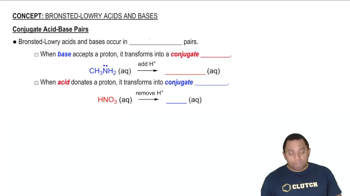Here are the essential concepts you must grasp in order to answer the question correctly.
Buffer Solutions
A buffer solution is a system that resists changes in pH upon the addition of small amounts of acid or base. It typically consists of a weak acid and its conjugate base or a weak base and its conjugate acid. This equilibrium allows the buffer to neutralize added acids or bases, maintaining a relatively stable pH.
Recommended video:
Weak Acids and Bases
Weak acids and bases are substances that do not completely dissociate in solution. For example, ammonia (NH3) is a weak base that partially reacts with water to form ammonium ions (NH4+) and hydroxide ions (OH-). Understanding the behavior of weak acids and bases is crucial for predicting how they will interact in buffer solutions.
Recommended video:
Conjugate Acid-Base Pairs
Conjugate acid-base pairs consist of an acid and a base that differ by a single proton (H+). For instance, NH3 (base) and NH4+ (conjugate acid) form a pair. The presence of both components in a solution is essential for creating a buffer, as they can react with added acids or bases to minimize pH changes.
Recommended video:
Conjugate Acid-Base Pairs
 Verified step by step guidance
Verified step by step guidance


